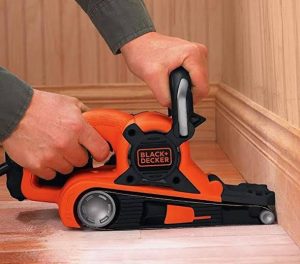Table of Contents
Introduction
Belt sanders can help you handle your tedious sanding jobs and make them quicker and more effective. They are powerful tools, and the best of them have different features that help make your sanding jobs more comfortable and faster without adding the physical effort that hand sanding will take. Various brands of belt sanders exist, such as Makita, WEN, and Porter-Cable. Even though there are multiple brands of belt sanders in the market with unique attributes, many of them work in the same fundamental way and can carry out the same tasks.
Belt sanders are aggressive on wood, so they are used for the initial phases of wood sanding or to remove materials quickly. They can be often used to remove paints or finishes from wood. Belt sanders can also help to give an entirely smooth surface as it is inbuilt fine-grit sandpaper.
How to Use a Belt Sander
You can use your belt sander as a stationary belt sander by clamping your belt sander in a standing position on your workbench. After attaching it to the bench, you then lock the trigger in the ‘on’ position. After clamping and switching on the sander, you can hold the wood against the belt to shape the wood. You can use stationary sanders as a tool sharpener for grinding chisels, gouges, and plane irons.
As you use your belt sanders, ensure that you keep it always moving because when you leave it in a spot, it can create a gouge inside your materials. You can move it from side to side or forwards and backward always.
Remember to use your belt sander gently because it is massive, and it will extract pressure on your wood for proper sanding. If you put more pressure, it can damage your material, leading to gouging, which is not good.
If you want to sharpen your chisels and more, ensure that you use the stationary belt sander and observe the necessary precautions by removing all sawdust from your dust bag before starting.
Select your sandpaper before embarking on the project. Course grit paper is suitable for cutting down rough surfaces, and fine paper gives your wood a smooth feel and look. The more the number, the coarser the grain.
When sanding down your deck, ensure you remove all metal objects like screws and nails because they can cause severe and irreversible damage to your sanding belt.
To use the belt sander to remove paint, stain, or varnish, you need to start with a coarse grit belt, for instance: a 60-grit belt. Then, you will move your belt sanders across the area you are working in. After using the site for a few times, with finer and finer grits until you get to the point that you are cool with your working surface’s smoothness. If you are sanding down on wood, work with the grain and not against it. You can put pressure on your wood, however, do not put too much pressure because you might clog up the belt.
You read the post below to check out How to repair a sander belt
Types of Belt Sanders
Belt sanders are of different types. They can be: Handheld belt sanders, which can be handheld and moved over the material, or they can be stationary or fixed.
Stationary belt sanders can remove non-ferrous metals like aluminum. These metals can clog grinding wheels and make them useless for smoothing soft metals. As the small grooves in the sandpaper get opened up as they move around the drive wheel’s arc, belt sanders are less susceptible to clogging.
There are different sizes of belt sanders, starting from the small handheld unit to units that are wide enough for sanding a full 1.2 by 2.5 m (4-by-8 foot sheet) of plywood in a manufacturing plant. Other belt sanders can be as big as 1.2 by 0.7 meters (3 ft 11 in x 2 ft 4 in). Sanding wood creates a lot of sawdust. It can be a cloth filter bag connected to a portable sander or a bigger vacuum system to draw dust particles into a central collector.
Safety Measures When Using Belt Sanders
There are necessary safety measures you need to take when using your belt sanders. They are as follows:
- Protect your ears because belt sanders can be very lot and damage your eyes if you are not careful. Ensure that you wear earplugs when using them.
- Always wear your dust while working with belt sanders. Although they have dust bags and other parts that reduce the amount of dust released, they still remove enough dust to be dangerous to your health.
Learning about belt senders can reduce the possibility of an accident happening, click here to read on When to use a belt sander
Conclusion
A belt sander is an essential tool in your arsenal. It is multipurpose and can tackle many of the sanding jobs that seem impossible in a short time. Therefore, get your belt sanders and get to work!

